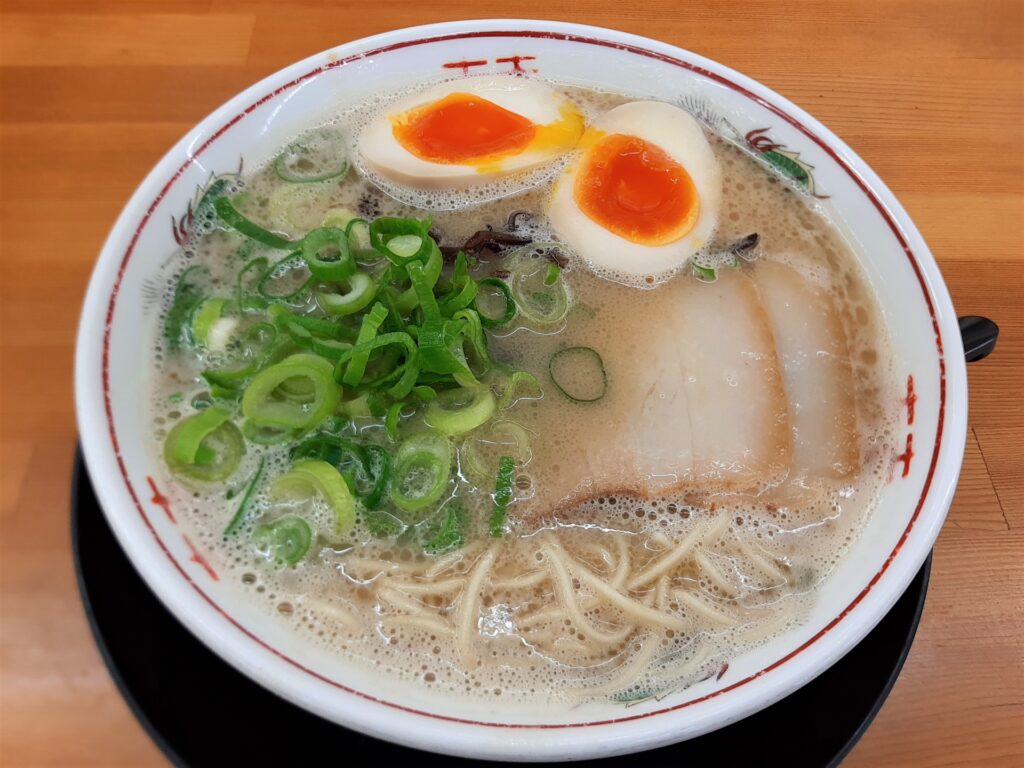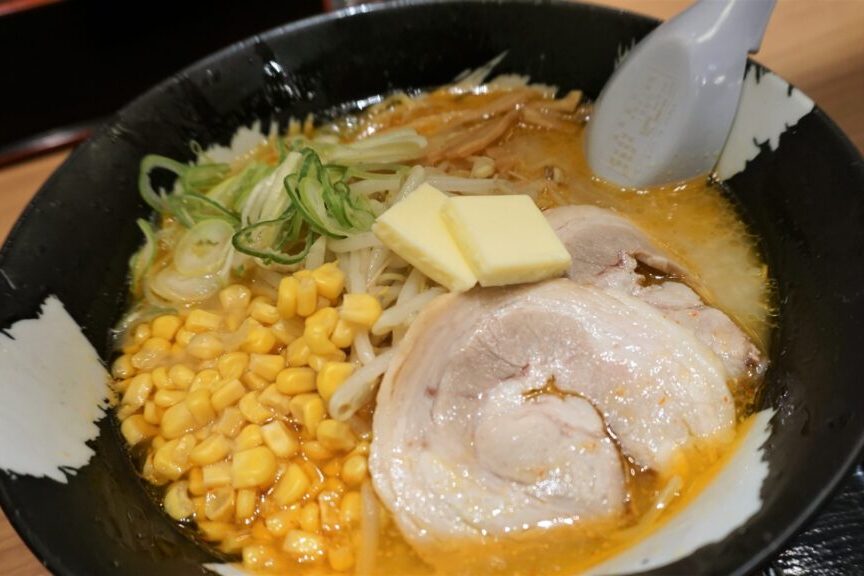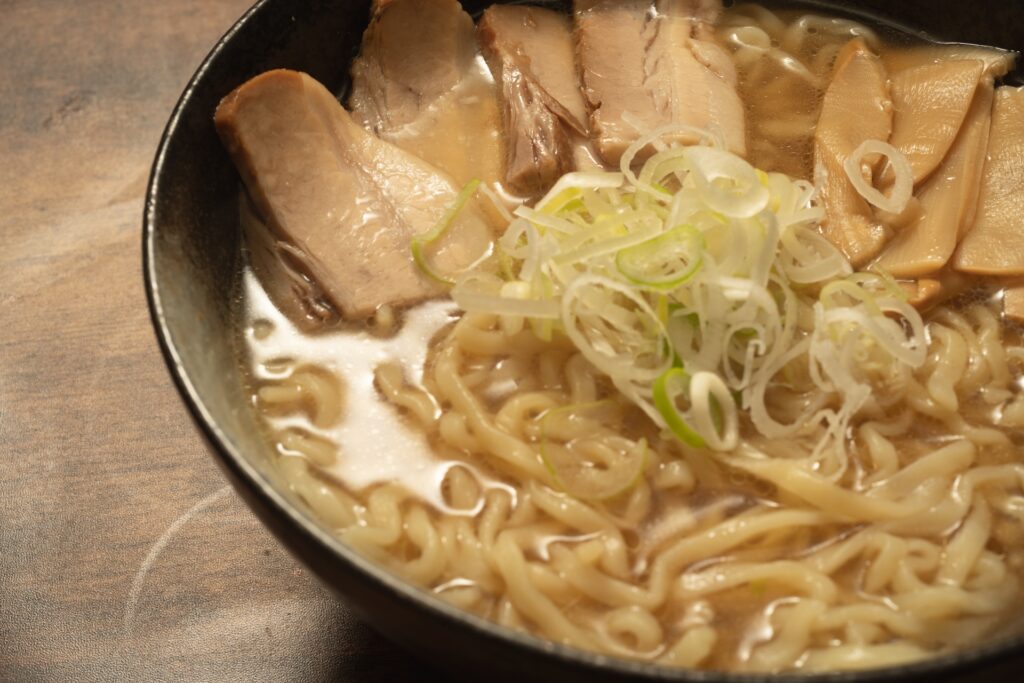
Ramen, which can be described as a Japanese soul food loved by foreign tourists, is affordable and easy to enjoy. While the noodle culture itself is said to have originated from China, Japanese ramen has developed its own unique evolution and offers a delicious dining experience that cannot be replicated in other countries. Throughout its history of approximately 100 years, numerous varieties of ramen have been created.From Hokkaido in the north to Okinawa in the south, each region has its own distinct flavor known as “local ramen.” When it comes to ramen in Hokkaido, locals always think of miso ramen. However, in the region of Hakodate in Hokkaido, salt ramen is the most famous. In the Kyushu region, tonkotsu (pork bone) ramen takes the spotlight. In places like Kitakata in Fukushima, soy sauce ramen is renowned. In Okinawa, the most beloved noodle dish is called Okinawa soba, which includes large chunks of pork belly and is different from traditional ramen.As such, Japan is filled with regional ramen flavors that are unique to each area. Not only the soup, but also the noodles come in a wide variety, including thick, thin, and curly noodles, cleverly designed to complement the broth. The noodles in tonkotsu ramen, for example, are thin and straight, resembling fine wires, while curly noodles pair well with soy sauce ramen.Moreover, the toppings placed on the ramen vary significantly. Miso ramen is topped with plenty of corn and bean sprouts. Sanma-men, a familiar dish in Yokohama, is generously topped with stir-fried vegetables in a thick sauce. Shoyu (soy sauce) ramen often features simple toppings such as chashu (roasted pork slices), naruto (fish cake), and green onions. Thus, Japan’s ramen culture has undergone unique variations within its small nation, with each region having its own original ramen.Ramen is loved by a wide range of people in Japan, from children to the elderly. It is a fulfilling and reasonably priced meal, often costing less than 1000 yen. Ramen can truly be considered a culinary culture that Japan should be proud to showcase to the world.
About Ramen
In Japan, there are various types of noodle dishes, such as soba and udon, in addition to ramen. The definitive difference between ramen and other types of noodles is that ramen uses Chinese noodles. And the key ingredient used to make these Chinese noodles is an alkaline salt solution called “kansui.”Adding “kansui” gives the Chinese noodles a unique flavor, texture, and color that is different from udon and soba. Although there are rare cases where ramen noodles are made without using “kansui” depending on the shop or region, strictly speaking, if “kansui” is not included, they are classified as udon under Japanese regulations.In other words, the most important aspect of ramen is the noodles. While the soup in ramen tends to attract more attention, I encourage you to pay attention to the taste of the noodles as well.
Flavor of Ramen
Soy Sauce Ramen(醤油ラーメン)
In Japan, the most common type of ramen is soy sauce ramen. About a hundred years ago, it is said that the first ramen shop in Japan, located in Asakusa, Tokyo, served soy sauce ramen.Soy sauce-based seasoning is combined with broth made from pork, chicken, seafood, and so on, but the types of soy sauce and broth can vary greatly depending on the shop or region. Therefore, even though it’s referred to as soy sauce ramen, there is a wide variety of flavors. The impression when eaten can also significantly differ depending on the type of noodles combined.
Salt Ramen(塩ラーメン)
Generally, salt ramen is considered to be lighter. Unlike soy sauce or miso, salt itself does not have a color, so by using a clear broth, it gives the ramen a transparent appearance.Compared to soy sauce ramen or miso ramen, salt ramen allows the characteristics of the ingredients to stand out more easily, so it could be said to be a type of ramen that can’t be disguised. Recently, there has also been an increase in salt ramen with a robust flavor, with plenty of umami added to the salt seasoning and broth.
Miso Ramen(味噌ラーメン)
While not as commonly found in restaurants as soy sauce or salt ramen, miso ramen is also familiar to Japanese people. A major contributor to this is undoubtedly the Sapporo miso ramen from Hokkaido.The unique flavor of miso ramen is created by frying miso, vegetables, and broth in a high temperature Chinese wok.A generous amount of lard floats on the surface, giving it a rich flavor. At the same time, it acts like a lid, preventing the soup from cooling down.
Tonkotsu Ramen(豚骨ラーメン)
Especially popular in Kyushu is tonkotsu ramen. The soup is typically made by boiling pork bones for a long time until it turns milky white, with its richness and flavor varying depending on the boiling time and the parts of the pork used.The use of thin noodles is also characteristic, and because the amount of noodles is relatively small, especially in the Hakata area of Fukuoka Prefecture in Kyushu, many shops adopt a system where only the noodles can be refilled, a practice known as “kaedama”. Also, one distinctive feature of tonkotsu ramen throughout Kyushu is the relatively frequent use of garlic as a seasoning.
Chicken Paitan Ramen(鶏白湯(とりぱいたん)ラーメン)
Chicken Paitan Ramen is made with a soup that has been boiled for a long time with chicken until it turns milky white. It may look similar to tonkotsu ramen, but the taste is completely different.With tonkotsu ramen, depending on the shop or region, there can be a distinctive smell that might be off-putting to some, but this is not typically seen with chicken paitan ramen. Compared to tonkotsu ramen, chicken paitan ramen is less likely to be divisive in terms of likes and dislikes, and can be considered an easy-to-eat ramen.
Tsukemen(つけ麺)
Tsukemen is a dish where, like cold soba, you dip noodles into a soup to eat them. While ramen usually involves serving freshly boiled noodles in hot soup, tsukemen instead involves serving noodles that have been cooled with cold water separately from the soup.Due to its focus on the noodles, tsukemen typically features thicker noodles and in larger quantities than ramen. Additionally, the soup is generally more heavily seasoned to not be overpowered by the noodles.This leads to a practice called “soup-wari,” where after you finish eating the noodles, the soup is diluted with a separate broth for drinking.
Related Content
Abura Soba(油そば)
Abura soba, simply put, is ramen without soup, and is also referred to as “soupless” or “maze soba”.While it might feel odd to categorize a dish without soup as a type of ramen, it is widely accepted in Japan.The distinguishing feature of abura soba is that you eat the noodles mixed with a small amount of sauce. As the sauce tends to settle at the bottom, it’s recommended to mix it well before eating. Despite its name, “oil soba”, it’s actually said to be lower in calories than ramen, given that it doesn’t include soup.
Related Content
Place(地域・地方)
Yokohama(横浜家系ラーメン)
Yokohama Iekei Ramen is a pork-bone soy sauce ramen that originated in Yokohama, Kanagawa Prefecture, Japan. The rich soup, characterized by a broth made from pork bones combined with soy sauce and topped with chicken oil, is its key feature. This soup pairs well with the thick, straight noodles. Over the past few years, the number of restaurants serving this popular ramen has increased nationwide. The standard toppings include spinach, char siu pork, and seaweed, though some places also add a flavored egg. Iekei ramen was created in 1974, and the restaurant “Yoshimuraya” in Yokohama, which opened in that year, is considered the original source of this style of ramen. Many derivative restaurants use the word “house” (in Japanese, ie) in their names, hence the term “Iekei” (House-style) Ramen.
Sapporo(札幌ラーメン)
Sapporo Ramen, originated in Sapporo, Hokkaido, is one of the most widely recognized regional ramen styles in Japan. Unlike other regional ramen where the soup flavor is typically fixed, Sapporo Ramen offers a variety of soup flavors including miso, salt, and soy sauce. The characteristic feature of Sapporo Ramen lies in its noodles, which are medium-thick and curly, providing a good balance with the soup. The history of Sapporo Ramen dates back to 1922 when a Chinese restaurant in the city introduced a precursor of Sapporo Ramen. Initially, only soy sauce and salt flavors were available, but miso flavor was later added. Sapporo Ramen became even more popular nationwide thanks to the catchy commercial jingle of Sanyo Food’s instant ramen product “Sapporo Ichiban”. Today, not only can you find Sapporo Ramen in instant form, but there are also many restaurants serving Sapporo Ramen outside of Sapporo, allowing the flavor of Sapporo to be enjoyed all over Japan.
Related Content
Hakata Tonkotsu Ramen(博多とんこつラーメン)
Hakata Tonkotsu Ramen, originating from the Hakata district of Fukuoka City, Fukuoka Prefecture, is characterized by its white, cloudy soup and ultra-thin noodles.The typical ingredients are green onions, wood ear mushrooms, and char siu. Mustard greens are usually available on the table for adding partway through the meal, which is a popular way to enjoy this dish.One unique feature of Hakata Ramen is the ability to choose the hardness of the noodles. You can select from “very hard”, “hard”, “regular”, “soft”, or “very soft”.”Very”, as in “very hard”, translates to “bari” in the local dialect of Fukuoka. It seems that the people of Fukuoka prefer harder noodles, as the majority of orders are “very hard” or “hard”.While there are various theories about the origin of Hakata Ramen, it is said to have originated from a ramen dish developed in 1937.Hakata Ramen is popular not only in Japan but also overseas. Many ramen chain restaurants that have expanded overseas, such as “Ippudo” and “Ichiran”, serve Hakata Ramen.
Related Content
Fukushima(喜多方ラーメン)
Kitakata Ramen is a local specialty from Kitakata, Fukushima Prefecture.Alongside Sapporo Ramen and Hakata Ramen, it is referred to as one of the three major regional ramen styles in Japan. The ratio of ramen shops to the population in the city is the highest in Japan, making it a beloved ramen dish both locally and nationwide.The soup is characterized by a light soy sauce flavor. The broth varies from shop to shop, with some using pork bones, dried sardines, or chicken bones, providing a simple yet diverse taste experience.The noodles used are “flat matured high-moisture noodles”, which are thicker and chewier due to their high water content.The main toppings are char siu, bamboo shoots, green onions, and narutomaki (a type of fish cake). It has the typical look of ramen that one might expect to see in an anime or manga.The origins of Kitakata Ramen date back to 1927. Soon celebrating its 100-year invention anniversary, Kitakata Ramen is a traditional ramen dish. Although not flashy, it continues to be loved and represents Japanese ramen.
Related Content



